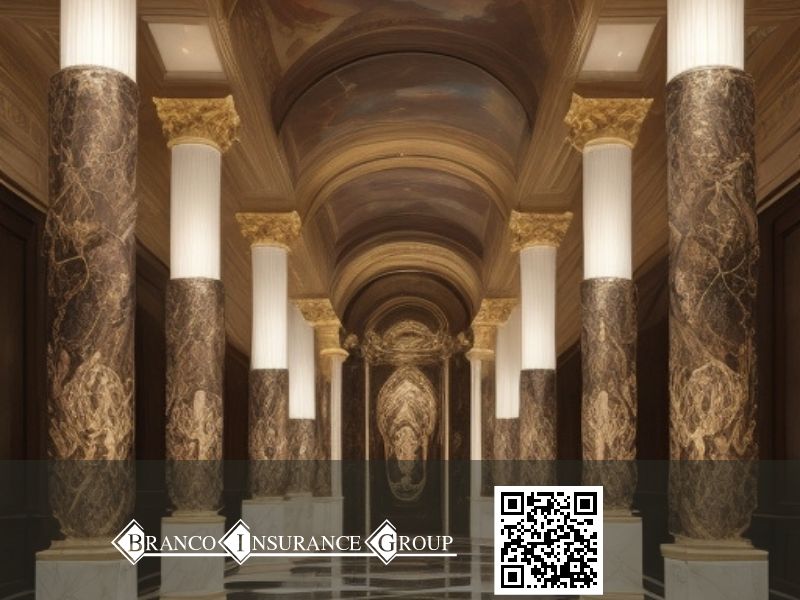
Mental Health Awareness Month: Prioritize the Mind, Support the Heart
May is Mental Health Awareness Month, a time to reflect on the importance of emotional well-being and the invisible battles many face daily. At Branco

Art collectors are often intrigued by the charm and value of their collections, but what about protecting that allure through insurance? Did you know that insuring an art piece priced at $10,000 could cost as low as $100 to $200 per year? This blog post is your guide to exploring the myriad options available for insuring your precious art pieces.
Stay tuned – we’re about to delve deep into the world of Art Collection Insurance!
Insuring your art collection provides protection against damage, theft, and loss, safeguards your financial investment, and gives you peace of mind.
Art insurance keeps your pieces safe. It steps in when bad things happen like theft, fire or water harm. The policy pays you if your art gets lost or ruined. This gives a full cash back for the art’s value.
Pieces on show are also under protection while they are on view to the public. So, an art owner can rest easy knowing that their prized items have protection against all odds with this insurance plan.
Art is more than just a pretty thing to look at. It can be a huge financial investment too. You buy art because you love it, but also because it may go up in value over time. That’s why it’s so important to keep your artwork safe.
Think of an insurance policy like a safety net for your money. If something bad happens to the art, such as theft or damage, the insurance helps you get that money back. This way, your hard-earned dollars stay protected and your financial future stays secure.
Having insurance for your art gives you peace of mind. You won’t worry about damage, theft, or loss anymore. It ensures the safekeeping of your precious art collection and acts as a shield in case of any incident.
This way, both artists and art collectors can relax. They know their financial security is not at risk due to their artwork’s vulnerability without proper protection from an insurance policy.
There are three main types of art collection insurance coverage: fine arts insurance, valuable articles coverage, and inland marine fine art & museum insurance.
Fine arts insurance is a type of coverage that protects various types of art collections, including paintings, sculptures, rare books, historical artifacts, and scientific inventions.
It offers flexible options tailored to the specific needs of individual collectors. With worldwide coverage and potentially no deductible for most losses, fine arts insurance provides protection against risks such as theft, damage, and loss.
Additionally, it may include automatic coverage for new items added to the collection. This insurance ensures peace of mind for art collectors by safeguarding their valuable investments and mitigating potential financial losses.
Valuable Articles Coverage is an important type of insurance that provides protection for your art collection and other valuable items. This coverage is designed to ensure that high-value items like artwork, collectibles, and other valuables are properly insured against damage, theft, or loss.
While homeowner’s insurance policies may provide some coverage for these items, they often have limitations and exclusions that may not fully protect your art collection. That’s why it’s recommended to obtain specialty art insurance or valuable articles coverage.specifically tailored to the needs of art collectors.
With this type of coverage in place, you can have peace of mind knowing that your valuable possessions are safeguarded against any unforeseen events.
Inland Marine Fine Art & Museum Insurance is a type of coverage specifically designed for art collections, including paintings, sculptures, prints, and special collections of historical, cultural, and technological significance.
It provides protection when your artwork is on exhibition or loaned to other institutions. This insurance falls under the category of inland marine insurance, which covers materials and equipment that are in transit or away from their primary locations.
It is especially important for corporate art collections and trade show exhibits as it safeguards against potential risks during transport or display. IMUA is the national trade association representing more than 400 insurance companies that write 90% of inland marine insurance in the U.S., making them a trusted source for this specialized coverage.
Coverage highlights and benefits include worldwide coverage for new purchases, protection for various types of art collections, and reimbursement for restoration and conservation expenses.
Want to know more about art collection insurance? Keep reading!
Art collection insurance provides worldwide coverage for new purchases, ensuring that your valuable pieces are protected no matter where they are. Whether you’re acquiring art internationally or bringing it home from a different location, this coverage extends to items in transit or on loan.
The insurance policy uses agreed values to determine the coverage amount, and best of all, there are no deductibles required. This means that you can have peace of mind knowing that your recent acquisitions are fully insured and safeguarded against any unforeseen circumstances.
Fine art insurance provides coverage for various types of art collections, including private collections and institutional collections. Whether you have valuable artwork displayed at home or own a gallery with numerous pieces, you can find insurance policies that protect your investments.
Private art collections can be insured under scheduled or blanket fine art insurance policies. This means you can choose to individually list each piece or get coverage for the entire collection as a whole.
With the right insurance provider, your artworks will be protected against damage, theft, and loss no matter where they are located. So whether you’re an individual collector or manage a public institution, there are coverage options available to safeguard your valuable assets.
Your art insurance policy can provide reimbursement for restoration and conservation expenses. If your artwork gets damaged, the insurer will evaluate the damage and determine if it can be fixed through restoration.
The cost of restoring the artwork would then be covered by your insurance policy. Additionally, if the damage affects the value of the artwork, you may also be reimbursed for any loss in value caused by the damage.
It’s important to note that these reimbursements are based on the insurer’s valuation of the artwork. So, when you’re choosing an art insurance provider, make sure to consider their reimbursement policies for restoration and conservation expenses.
The cost of art insurance is influenced by several factors such as the value of the collection, security measures in place, location and storage conditions, and previous loss history.
The value of your art collection is an important factor that affects the cost of art insurance. The size and worth of your collection will determine how much coverage you need and how much you’ll pay for insurance.
Whether you have a small collection with lower-priced works or a larger, more valuable collection, there are insurance options available to protect your assets. Museums and institutions that house art collections also need to consider the value of their assets when purchasing insurance.
So, no matter the value range or type of collection, it’s essential to ensure the proper coverage to safeguard your investment.
Keeping your art collection safe and protected is crucial when it comes to insuring it. Insurance companies take into account the security measures in place to determine the risk level of art insurance.
Factors such as safety protocols, risk assessments, and security systems play a significant role in influencing the cost of art insurance. Insurers also consider where your artwork is located and how it is stored or displayed.
Furthermore, they examine how often the artwork is transported, as this can increase the risk of damage or theft. By implementing comprehensive security measures like robust alarm systems, surveillance cameras, secure storage facilities, and proper transportation security protocols, you can help reduce the overall cost of insuring your valuable art collection while providing added protection for your prized possessions.
The location and storage conditions of an art collection play a crucial role in determining the insurance cost. Insurance providers consider factors such as the geographical location, preservation conditions, storage facility, and security measures in place to assess the level of risk.
For example, if the collection is stored in an area prone to natural disasters or has inadequate security measures, it may be considered higher risk and result in higher insurance premiums.
Museums and cultural institutions that house valuable collections may face significant insurance costs due to their unique risks. Therefore, maintaining a secure storage location with suitable environmental conditions is essential not only for minimizing potential damage but also for keeping insurance costs manageable.
Your previous loss history plays a significant role in determining the cost of insuring your art collection. Insurance companies consider factors like your past claim history, loss record, and frequency of claims when assessing your risk profile.
If you have experienced losses or filed multiple claims in the past, it may result in higher insurance premiums for your art collection. On the other hand, if you have a clean loss record and haven’t had any previous claims, it can lower the cost of your art insurance coverage.
So, maintaining a good loss history is crucial to managing the overall cost of protecting your valuable artwork and obtaining affordable coverage from insurers.
Homeowners insurance may provide some coverage for art collections, but it often has limitations and exclusions. To fully protect your valuable artworks, it’s important to explore additional coverage options specifically tailored for art collections.
Read on to learn more about insuring your art collection and how to choose the right insurance provider.
Homeowners insurance may not fully cover your art collection due to limitations and exclusions. Many policies have a maximum insurance limit for art and collectibles, which means you may not receive the full value of your artwork if it’s damaged or stolen.
Standard homeowners insurance policies might provide some coverage for paintings and other collectibles, but it’s typically not enough to protect a fine art collection. In addition, there may be exclusions in fine art insurance policies for certain events like war or nuclear accidents.
Climate change has also made insuring art more expensive, so it’s important to review your policy carefully and consider specialized coverage options for your valuable pieces.
If you’re looking for additional coverage options for your art collection, there are a few things to consider. One option is a floater policy, which provides itemized coverage for specific valuable items like fine art and collectibles.
This type of insurance can offer more extensive coverage than standard homeowners policies, including protection against breakage, flood damage, and mysterious disappearance. Another option is to consider adding scheduled personal property coverage to your renters or homeowners policy.
This allows you to increase the limits on certain items, such as artwork or jewelry, ensuring they are fully protected in case of loss or damage.
Renters insurance may provide some coverage for your art collection, but it often has limitations. Read on to learn more about the coverage options and additional protection you might need.
Renters insurance provides coverage for art collections up to the policy’s limit, including valuable possessions like coins and paintings. However, it’s important to note that there may be limitations on how much coverage is available for these items.
Homeowners insurance generally covers artwork as well but is subject to policy limits. It’s crucial to carefully review your policy and understand the coverage limitations in order to ensure that your art collection is adequately protected.
Scheduled personal property coverage is an optional type of insurance that you can add to your homeowners or renters insurance policy. It allows you to separately insure high-value items, like your art collection, from your standard personal property coverage.
This means that if something were to happen to your valuable belongings, such as damage or loss, they would be protected under this enhanced coverage. However, it’s important to note that the amount of coverage and specific requirements may vary depending on your insurance provider.
So if you have a valuable art collection, it’s worth considering adding scheduled personal property coverage for additional peace of mind and protection.
Look for A-rated insurance companies or specialized art insurers, and consult with an insurance agent to find the best coverage for your art collection. Read on to discover more tips for managing art collection risks.
One of the key factors in choosing the right art insurance provider is finding an A-rated company. These companies, like AXA XL, have a strong financial rating and are known for their stability and reliability.
AXA XL specializes in fine art and private collections insurance, offering comprehensive coverage for protection against theft, damage, and loss. They are recognized as one of the top art insurance providers in the industry and provide competitive pricing options.
With AXA XL’s A-rating and expertise in insuring valuable art collections, you can have peace of mind knowing that your investments are well protected.
Specialized art insurers are insurance providers that focus specifically on art and understand how claims and appraisals for artwork are handled. They have expertise in art insurance and understand the unique needs and risks associated with insuring artwork, whether it’s on display in museums, galleries, or auction houses.
AXA XL is one such provider that offers high-standard coverage for private collections, including fine art. It’s important to choose a specialized art insurer when insuring an art collection to ensure that your valuable pieces receive the right coverage and protection.
Choosing the right art insurance provider can be a complex task. That’s why it is important to consult with an insurance agent who specializes in art collection insurance. An insurance agent can provide valuable guidance and expertise, helping you navigate through different options and find the coverage that best suits your needs.
They have knowledge about top fine art insurance companies like Progressive, AXA, and Chubb, which offer high-standard insurance coverage for various classes of private collections including fine art.
Additionally, fine art insurance brokers can assist you in understanding the intricacies of art insurance policies and help you make an informed decision. With their assistance, you can ensure that your valuable art collection is properly protected against risks such as damage or theft.
Properly document and appraise your art collection, ensuring you have accurate records of each piece’s value and condition.
Proper documentation and appraisal are essential when managing the risks associated with insuring your art collection. It’s important to have proof of ownership, such as a bill of sale, along with documentation like provenance and replacement value estimates.
Photographs of your artwork are also crucial for insurance purposes. Additionally, getting a fine art appraisal can help determine the value of your pieces and provide clear title if you decide to sell inherited works in the future.
By keeping thorough records and regularly updating appraisals, you can ensure that your art collection is adequately protected by insurance.
Properly securing and displaying your art collection is essential to protect it from theft, damage, and other risks. To ensure the safety of your artwork, consider storing it in specialized containers or storage units specifically designed for art preservation.
These containers provide protection against environmental factors like humidity, temperature fluctuations, and pests. Additionally, using secure display techniques such as installing alarms and surveillance systems can help deter potential thieves.
By taking these measures to safeguard your collection, you can mitigate risks and preserve its value for years to come.
Regular condition inspections are a crucial part of managing the risks associated with art collection insurance. These inspections involve regularly checking and examining the artworks to ensure their physical condition is well-maintained.
By conducting these inspections, potential damage, loss, or deterioration can be identified early on. The frequency of inspections may vary depending on the specific collection and its needs.
Proper documentation and records should also be maintained during these inspections to keep track of any changes or issues discovered. This proactive approach helps safeguard the artwork and ensures that any necessary steps for restoration or conservation can be taken promptly to preserve its value and integrity.
Insuring your art collection is a smart move to protect your investments and give you peace of mind. Whether you choose fine arts insurance or homeowners insurance with additional coverage options, it’s important to carefully document and appraise your artwork. If you have any questions about getting the right insurance for your art collection or if you are ready for a quote, our insurance experts at Branco Insurance Group are ready to help you. Contact us today to get the process started.
Art collection insurance is a type of insurance that provides coverage for valuable artworks against risks such as theft, damage, or loss.
You need art collection insurance to protect your valuable artworks from unforeseen events that could result in financial loss, such as theft, fire, or natural disasters.
Art collection insurance works by assessing the value of your artwork and providing coverage based on that value. In the event of a covered loss, you will be compensated for the damage or loss up to the policy limits.
The cost of art collection insurance depends on various factors including the total value of your art collection, its location (whether it's kept at home or in a museum), its vulnerability to risks, and any additional security measures in place.

May is Mental Health Awareness Month, a time to reflect on the importance of emotional well-being and the invisible battles many face daily. At Branco

Two of Naugatuck’s long-standing insurance professionals have joined forces. Beginning on April 14th, the Healy-Lynn Insurance Agency has become a division of Branco Insurance Group.
